(* english below) Brad Klausen es un viejo conocido de esta santa casa, por eso cuando nos enteramos que hacia un libro de sus posters y ademas dedicado a una de nuestras bandas favoritas Pearl Jam, no lo dudamos. Teniamos que llamar a su puerta otra vez y que nos contara de su nuevo proyecto
FROM A BASEMENT IN SEATTLE, THE POSTER ART OF BRAD KLAUSEN: EXPANDED EDITION es una visión enorme al proceso creativo a través del cual el artista Brad Klausen ha hecho diseños para pósters de rock de bandas como Pearl Jam, así como Built to Spill, Queens of the Stone Age, U2, Soundgarden, Explosions in the Sky, MGMT, Mogwai, Faith No More, The Jesus Lizard, Widespread Panic y una lista interminable. Con introducciones de Eddie Vedder y Jeff Ament de Pearl Jam, esta edición ampliada en tapa dura también incluye nuevos pósters del archivo de Klausen.
Comenzando cronológicamente con el primer póster que creó, y abarcando más de setenta y cinco trabajos diferentes, el libro sigue el crecimiento y desarrollo del arte de Klausen. Junto a la imagen de cada póster terminado se incluyen bocetos y un comentario detallado sobre la historia detrás de la ejecución y el concepto de los diseños de cada banda.
Todas las piezas nunca antes vistas que se utilizaron para construir cada diseño están incluidas: los bocetos iniciales, los entintados finales, los elementos tipográficos dibujados a mano y por ordenador, y todos los demás componentes utilizados en la construcción de la pieza final. Klausen desmonta y descompone cada diseño para mostrar cómo se crea la obra, ofreciendo a los lectores una original forma de mirar por encima del hombro del artista, mientras esta en su escritorio con las manos en la masa.
BRAD KLAUSEN se graduó con una licenciatura en Bellas Artes en diseño gráfico en la Universidad de Denver en 1998. En 1999, comenzó a trabajar como diseñador gráfico interno para la banda Pearl Jam. En 2007, lanzó su propio estudio, Artillery Design, y en 2008 dejó su trabajo con Pearl Jam para enfocarse exclusivamente en la creación de pósters serigrafiados para bandas como Pearl Jam, Queens of the Stone Age, NIN, Foo Fighters y muchas más.

Brad, ¿qué te inspiró a crear “From a Basement in Seattle” y cómo surgió la idea para este libro?
La idea surgió de las mudanzas a lo largo de los años. Vivi en diferentes casas de alquiler en Seattle durante esos años. Cada vez que tenía que mudarme, tenía que sacar los cajones de mis archivadores planos para que fuera más fácil moverlos, y veía las pilas de dibujos originales que tenía. He guardado prácticamente todos los bocetos y entintados de cada póster que he hecho, así que hay muchas partes y piezas interesantes para revisar… y siempre me encanta ver los bocetos de mis artistas favoritos, me encanta ver la evolución de cómo un artista crea una obra. Pensé que era una pena que yo fuera la única persona que pudiera ver todos los bocetos, así que decidí que debía intentar hacer un libro para poder compartir la creación y la evolución de las imágenes. Todos ven el póster terminado, pero generalmente muy pocas personas ven los primeros bocetos, los borradores y el desarrollo de las ideas… así que esa fue la idea principal detrás del libro: dar un trasfondo de cómo los pósters cobraron vida.
¿Como conociste a Pearl jam? Tanto a nivel de fan de primero su musica y luego como los conociste a ellos? ¿Como empezaste a trabajar con ellos?
Como fan: Yo era como millones de otros jóvenes adolescentes en los 90, y cuando me presentaron la música que venía de Seattle, quedé totalmente consumido y enamorado de ella. Parte de ser adolescente es ese momento de madurez en el que te estás convirtiendo en tu propia persona, y la rebeldía y la angustia a menudo forman parte de esos años de adolescencia… así que para aquellos de nosotros que éramos adolescentes a principios de los 90, tuvimos uno de los mejores momentos de la historia de la música y la cultura como telón de fondo y banda sonora de nuestra angustia y rebeldía… Nirvana, Soundgarden, Pearl Jam, Alice in Chains, toda la ideología de la música y el arte que venía de Seattle, conectó con muchos de nosotros, era mucho más real, ruidosa y sin glamour, era sucia y grunge, todo lo que las mentes jóvenes deseaban. La explosión musical de Seattle me introdujo a la música y me hizo enamorarme de ella. Disfrutaba algo de música antes de eso, pero no fue hasta 1991 que quedé completamente enamorado de ella. En particular, los sonidos de guitarras fuertes, pesadas y distorsionadas… superfuzz bigmuff no es solo el título de un álbum, sino un estilo de vida.
Trabajando para ellos: Comencé a trabajar para ellos después de haber enviado al Ten Club un póster que diseñé, con una pequeña carta diciendo que si alguna vez necesitaban a alguien para hacer algún diseño o trabajo artístico, me encantaría. Respondieron como esperaba, con un simple “No, gracias”. Pero pensé, no puedes entrar si no llamas a la puerta. Curiosamente, 8 meses después de haber enviado ese póster al Ten Club, me llamaron y me pidieron que volara para una entrevista (vivía en Los Ángeles). Me llevaron, tuve una entrevista y poco después me ofrecieron un trabajo como diseñador gráfico interno.

Que sepamos has hecho posters, ¿pero nos puedes hablar de otros trabajos si los has hechos? ¿Y que te gustaría hacer? sueñas algun proyecto de hacer con la banda?
Curiosamente, durante los primeros 5 años trabajando para la banda, no hice ningún arte de pósters. Quería hacerlo mucho, pero estaba trabajando en el merchandising de las giras, del Ten Club, boletines y luego empecé a hacer arte de álbumes y empaques de DVD. En un momento, estaba diseñando invitaciones de cumpleaños para los miembros de la banda y básicamente cualquier cosa que necesitara arte.
¿Cuál es el enfoque principal del libro y cómo ha evolucionado desde la edición original hasta esta versión expandida?
El enfoque principal son las historias y los detalles detrás de la creación de cada póster. Poder ver algunos de los bocetos que dieron inicio a cada póster y mostrar cómo el diseño evolucionó desde la primera idea hasta la pieza final. La edición ampliada tiene una portada de tapa dura y una nueva imagen de portada de un póster que hice para Pearl Jam para un concierto que tuvieron en Washington DC en 2006, e incluye 6 pósters más, junto con sus bocetos y las historias detrás de ellos.

¿Cómo ha sido tu experiencia trabajando con Pearl Jam a lo largo de los años y cómo se refleja esta colaboración en el libro?
Bueno, como fan de la banda en mi adolescencia, trabajar para ellos y directamente con ellos ha sido una experiencia surrealista. Pero una vez superas el aspecto de “trabajar para tus héroes”, tuve la oportunidad de ver cómo operan artistas de su nivel. Pude ver cómo abordan el arte y cómo, a través de la devoción al arte, han logrado esculpir estas vidas increíbles para ellos mismos. Eso fue realmente inspirador, ver cómo el arte puede construir una existencia increíble que se retroalimenta y te permite seguir siendo un artista autosuficiente que se dedica a lo que realmente le interesa.
¿Qué desafíos enfrentaste al compilar y editar el contenido para la edición expandida del libro?
El mayor desafío fue decidir qué nuevos pósters incluir.
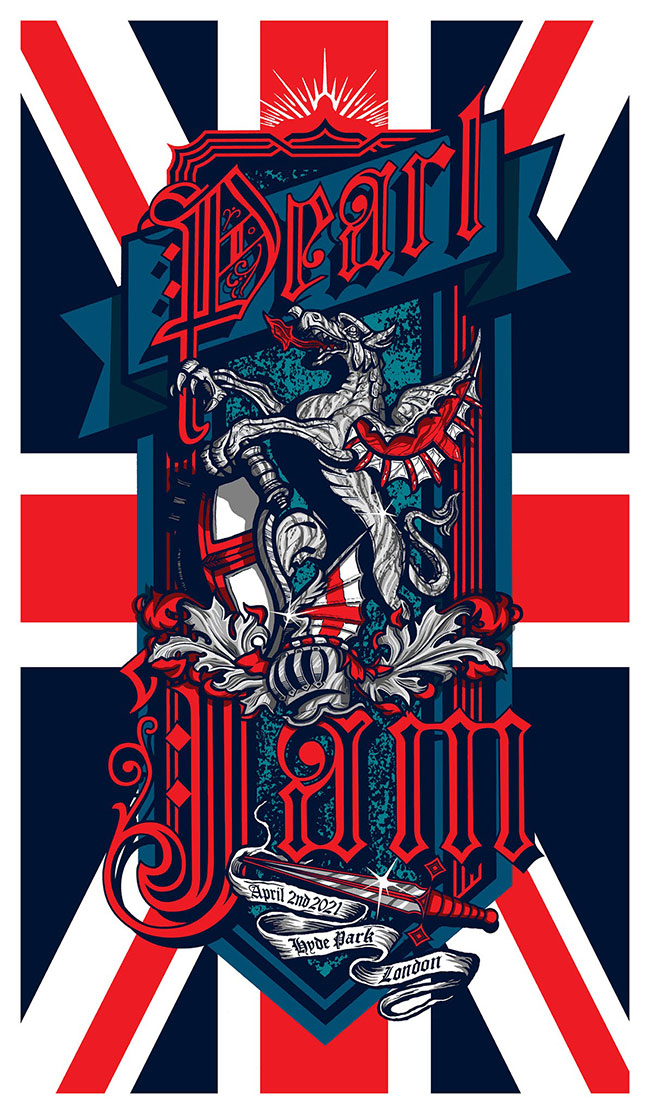
¿Puedes hablar sobre algún diseño específico de Pearl Jam que te haya presentado un desafío creativo o técnico? En el libro, se destacan varios posters y trabajos gráficos. ¿Cuál consideras que ha sido tu obra más innovadora y por qué?
Creo que en cada póster que hago para Pearl Jam, el desafío creativo es usualmente “¿qué voy a hacer esta vez?”. Después de años de hacer pósters para Pearl Jam, o para cualquier banda, esa pregunta se vuelve más difícil de responder. ¿Qué puedo hacer que no haya hecho antes? ¿Qué referencia puedo usar que no haya usado? ¿Qué ambiente puedo incorporar que no haya explorado?
Mi trabajo más innovador… mmmm, siento que mi respuesta cambiaría dependiendo del día que me preguntes, pero uno de mis favoritos es un póster que hice para Queens of the Stone Age, para un show en Salt Lake City en 2017. Me encanta LOOOOOOOVE Queens of the Stone Age, y ese póster está basado en su canción Feel Good Hit of the Summer, cuyas letras son solo una lista repetida de drogas que el cantante Josh Homme decía que llevaba mientras caminaba hacia el estudio para grabar el álbum. Para los fans, saben que Josh aprendió a tocar la guitarra con música polka… si escuchas su música, a menudo puedes escuchar el ritmo polka ump-pa que es la base del ambiente inquietante y groovy de circo gitano que caracteriza a Queens of the Stone Age… así que para esa imagen, representé las drogas mencionadas en la canción: nicotina, valium, vicodin, marihuana, éxtasis, alcohol y cocaína, todas asaltando a una banda de polka… y todo esto ocurre dentro de la mente de Josh Homme, los mecanismos creativos detrás de la magia. Puede que no sea mi póster más innovador, pero para mí es perfecto… y fue para un concierto en Salt Lake City, conocida por ser una ciudad más religiosa que se abstiene de los vicios, por lo que siempre es divertido presentar imágenes que pueden causar revuelo cuando el gran show de rock llega a la ciudad.
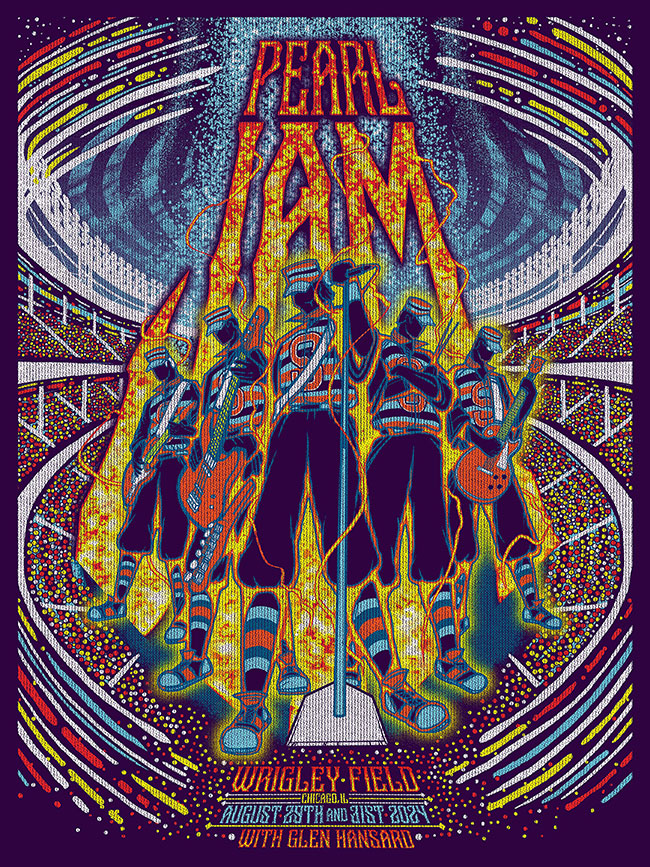
¿Qué papel han jugado los miembros de Pearl Jam en el proceso creativo y editorial del libro?
Con la excepción de que Jeff escribió el prólogo y Ed la introducción, no han tenido ningún papel en el aspecto creativo o editorial del libro.
¿Cómo ha cambiado tu estilo o enfoque de diseño desde que empezaste a trabajar con Pearl Jam hasta ahora?
Cuando recién salí de la universidad, estaba muy enfocado en usar todo el software de diseño que acababa de aprender, como Photoshop e Illustrator para todo. Tenía un estilo mucho más tecnológico, no me apoyaba tanto en el trabajo a mano, sino más en la manipulación de imágenes encontradas en Photoshop. Una vez que llegué a Seattle y empecé a trabajar para Pearl Jam, había una mayor dependencia en el arte hecho a mano, la ilustración y la pintura, así como la serigrafía. Un enfoque más analógico y orgánico en lugar de digital. Estar rodeado de todo eso me hizo volver a ilustrar a mano y eso abrió todo un nuevo aspecto en mi estilo. Y al trabajar con Jeff en el arte de los álbumes y otros proyectos, aprendí mucho solo con ver cómo él abordaba el arte, la libertad con la que dejaba que la creatividad se manifestara. La idea de que el arte, a menudo, es ese primer movimiento o creación inicial que ocurre de forma natural, la idea de que no hay “accidentes felices”.
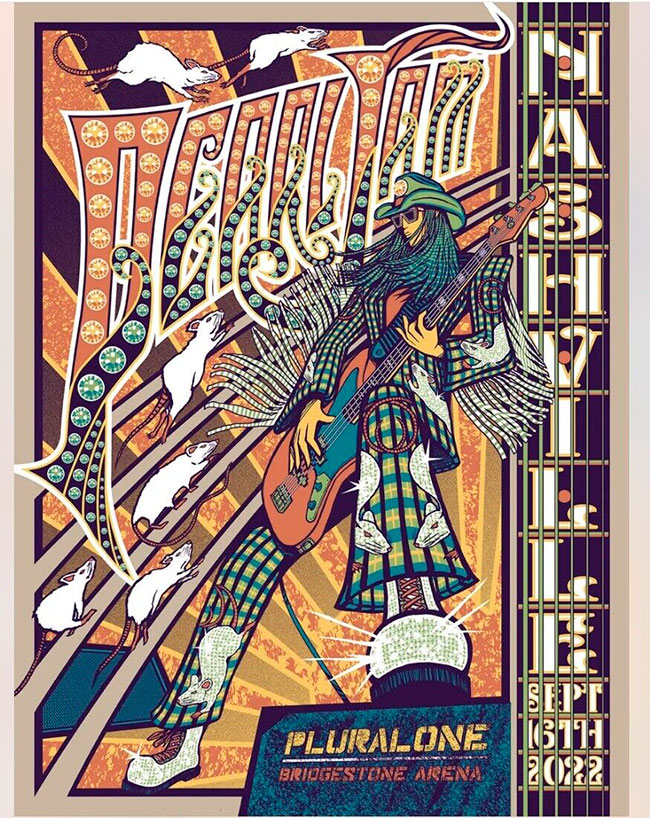
En el libro se menciona tu trabajo desde los inicios de Pearl Jam. ¿Cómo ha sido la evolución de la banda en tu trabajo gráfico a lo largo de los años?
Bueno, no estuve allí durante los primeros años. Comencé a trabajar para la banda a finales de 1999, así que ya estaban bien establecidos en ese momento. Sin embargo, he estado haciendo pósters para ellos durante 20 años, y la banda continúa evolucionando con cada álbum… y como artista de pósters intentas capturar los sonidos y la vibra de cada disco. No estoy seguro de poder señalar cambios específicos reflejados en mi trabajo, aparte de que, a medida que la banda envejece y yo también, espero que tanto nuestro trabajo respectivo se haya vuelto más reflexivo, desarrollado y perfeccionado a medida que continuamos intentando dominar nuestros oficios.
¿Cómo abordas la tarea de reflejar la identidad y el mensaje de una banda a través del diseño?
Es el aspecto más difícil de crear imágenes para bandas. Intentar convertir no solo la música, el sonido auditivo, en una representación visual, sino también representar visualmente el ethos, la ideología y la imagen de una banda. Lo primero que hago es escuchar la música, me siento con ella y veo qué imágenes o sensaciones evoca en mi mente. Ver grabaciones en vivo también ayuda a tener una mejor idea de cómo es ver a una banda en directo, cuál es la experiencia… pero luego, ¿cómo representas una experiencia, sensaciones y energía de manera visual? Si una banda es ruidosa y pesada, quizás uses imágenes y texturas más ásperas y oscuras en la composición, mientras que si la música de una banda es más suave y bonita, podrías usar líneas más limpias, más espacio negativo y colores más claros… intentas evocar la vibra de una banda en la vibra de la imagen. Es difícil de hacer, pero es parte de la diversión del trabajo. Y por eso es tan genial ver cómo diferentes artistas de pósters interpretan una banda y su música.

¿Qué impacto esperas que tenga este libro en los fanáticos de Pearl Jam y en los seguidores del diseño gráfico musical?
Espero que brinde a los fans de Pearl Jam y a los aficionados al diseño gráfico una mayor comprensión de lo que implica la creación de un póster de concierto. Podrán conocer los detalles internos de lo que ocurre detrás de la creación de cada pieza. Verán cómo se “hace la salchicha” y aprenderán más sobre cada imagen y las historias detrás de ellas. Como artista, siempre me encanta ver cómo se hace el trabajo de otro artista, así que espero que los artistas que lo lean encuentren algo útil al ver cómo hago mi trabajo, porque siempre es interesante ver cómo los artistas crean sus obras de manera similar o diferente.
¿Tienes planes para otros proyectos similares o colaboraciones en el horizonte que puedan interesar a los fanáticos del diseño gráfico musical?
Siempre estoy trabajando en pósters para diferentes bandas, así que los proyectos en el horizonte son más pósters para shows de rock and roll.
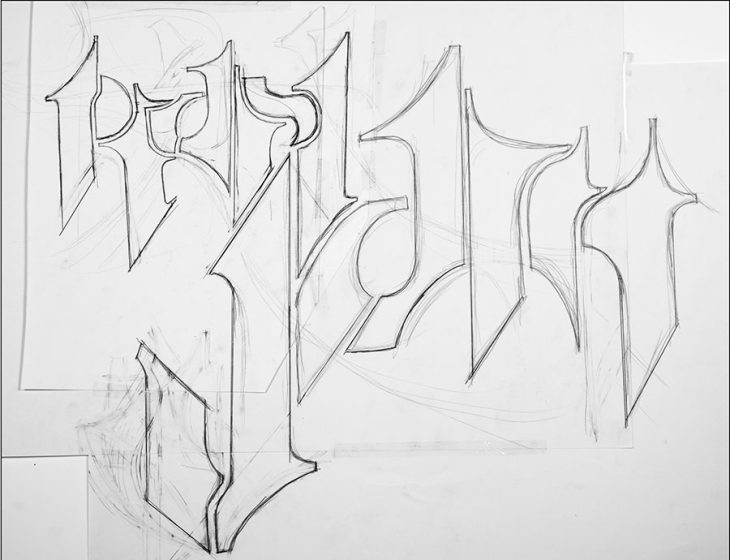

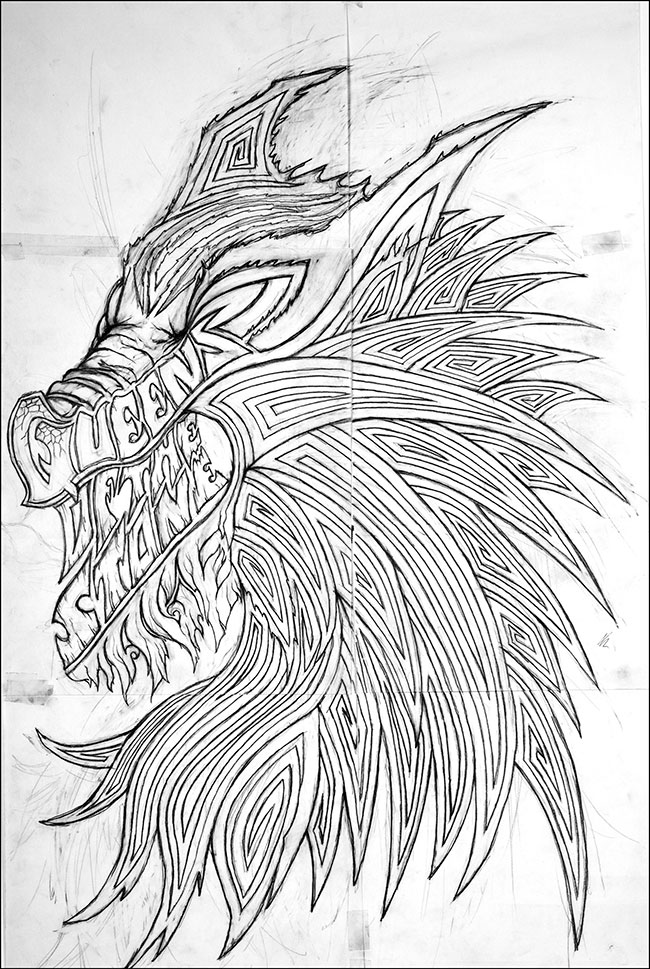
ENGLISH:
BRAD KLAUSEN.
FROM A BASEMENT IN SEATTLE…
FROM A BASEMENT IN SEATTLE, THE POSTER ART OF BRAD KLAUSEN: EXPANDED EDITION is an extensive look into the creative process through which artist Brad Klausen generates imagery for rock posters for Pearl Jam, as well as Built to Spill, Queens of the Stone Age, U2, Soundgarden, Explosions in the Sky, MGMT, Mogwai, Faith No More, The Jesus Lizard, Widespread Panic, and others. With introductions from Eddie Vedder and Jeff Ament of Pearl Jam, this expanded hardcover edition also includes new posters from Klausen’s archive.
Starting chronologically with the first poster he ever made, and covering more than seventy-five different works, the book follows the growth and development of Klausen’s art. Alongside the image of each finished poster are sketches and detailed commentary of the story behind the execution and concept of the individual designs.
All the never-before-seen pieces and parts that were used to build each design are included: the initial rough sketches, the final inkings, the hand-drawn and computer-drawn typographic elements, and all other elements used in the construction of the final piece. Klausen takes apart and dissects each design to show how the artwork comes together, providing viewers a a rare look over the shoulder of the artist.
Brad Klauen graduated with a BFA in graphic design from the University of Denver in 1998. In 1999, he began working as the in-house graphic designer for the band Pearl Jam. In 2007, he launched his one-man shop Artillery Design, and in 2008 he left his job with Pearl Jam to focus solely on making screen-printed posters for bands like Pearl Jam, Queens of the Stone Age, NIN, Foo Fighters, and many more.
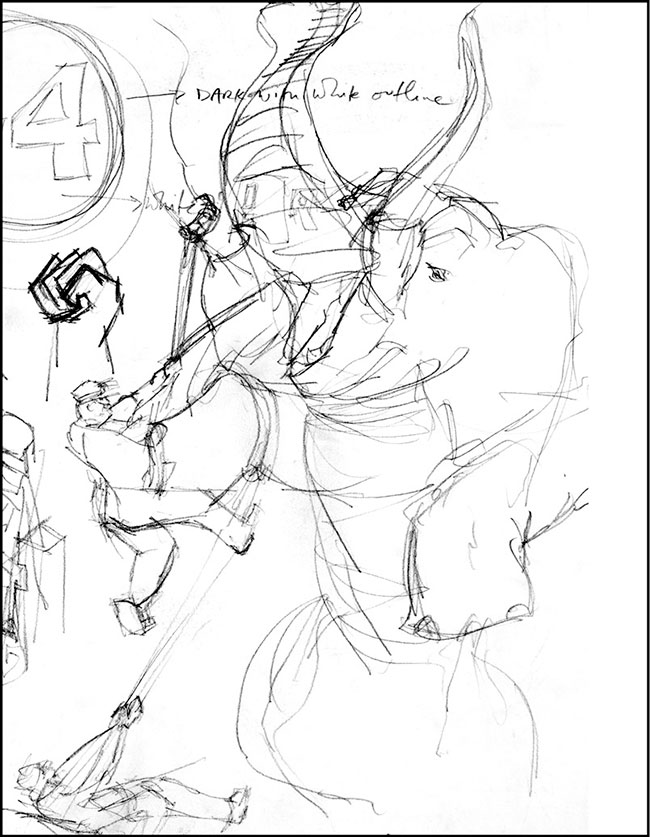
Brad, what inspired you to create “From a Basement in Seattle” and how did the idea for this book come about?
The idea came about from moving over the years. Staying in different rental houses in Seattle throughout the years. Every time I had to move I had to take the drawers out of my flat file drawers, to make them easier to move, and I would see the piles of original drawings I have. I have kept pretty much every sketch and inking of every poster I’ve ever made, so there’s a lot of interesting parts and pieces to look through… and I always love getting to see the sketches of my favorite artists, I love seeing the evolution of how an artist creates a piece. I thought it was a shame that I was the only person that got to see all the sketches, so I figured I should try and get a book made so I can share the creation and the evolution of the images. Everyone gets to see the finished poster, but generally very few get to see the early sketches and mock ups and development of ideas… so that was the main idea behind the book, to give a back story to how the posters came to life.
How did you first get to know Pearl Jam, both as a fan of their music and then personally? How did you start working with them?
As a fan: I was like millions of other young teenagers in the 90’s, and when introduced to the music coming from Seattle, was totally consumed and enamored with it. Part of being a teenager is that coming of age time where you are becoming your own person, and rebellion and angst is often a part of those teenage years… so for those of us who were in our early teens in the early 90’s we had one of the greatest moments in music history and culture to be the foreground and soundtrack of our angst and rebellion… Nirvana, Soundgarden, Pearl Jam, Alice n’ Chains, the whole ideology of the music and art coming from Seattle, it struck a chord with so many of us, and was so much more relatable and real and loud and not glam and glitz but dirt and grunge, and just everything young teenage minds crave. The whole Seattle music explosion really introduced me to music and made me fall in love with it, I enjoyed some music prior to that, but it was not until 1991 when I would become absolutely head over heels enamored with it. In particular, loud heavy fuzzy guitars…. superfuzz bigmuff, is not just an album title, but a way of life.
Working for them: I started working for them after I had sent the Ten Club a poster I had designed, with a small letter on it stating if they ever needed anyone to do any design / artwork for them I would love to. They responded back, as I expected with a simple “No thanks”. But I figured, you can’t get in if you don’t knock. Oddly enough 8 months after I had sent that poster in to the Ten Club, they called and asked if I could fly up for an interview (I was living in Los Angeles). They flew me up, I had an interview, and shortly there after they offered me a job as the in-house graphic designer.

We know you’ve done posters, but can you talk about any other work you’ve done with them? Are there any projects you dream of doing with the band?
Interestingly enough, for the first 5 years working for the band I didn’t work on poster art at all. I very much wanted too, but I was working on tour merchandise and Ten Club merchandise and mailers and newsletters, and then eventually started doing album art and art for dvd packaging… at one point I was designing birthday invitations for band members and basically anything anyone needed any art for at all.
What is the main focus of the book and how has it evolved from the original edition to this expanded version?
The main focus is on the stories and insight behind the creation of each poster. Getting to see some of the sketches that started each poster, showing how the design evolved from initial idea to finished piece. The expanded edition is a hard bound cover and has a new cover image of a Pearl Jam poster I did for a show they had in Washington DC in 2006, and includes 6 more posters and their sketches and stories behind them.
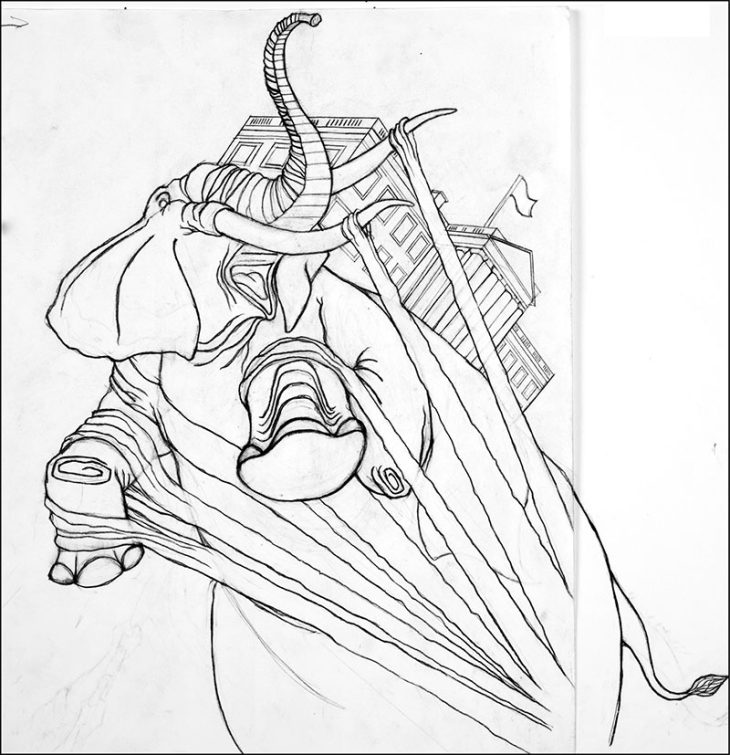
How has your experience working with Pearl Jam over the years been, and how is this collaboration reflected in the book?
Well as a fan of the band as a teenager, getting to work for them and directly with them has been a surreal experience. But once you get past the “working for your heroes” aspect, I got to have an inside view of what it’s like seeing how artists of their level operate. I got to see how they approach art and how through having a devotion to art, they were able to carve out these amazing lives for themselves. That was a truly inspiring aspect of the experience, seeing how pursuing art can build someone an unbelievable existence, that feeds on itself and allows one to just continue having more and more freedom to be a self sufficient independent artist who gets to spend their life focusing on what they want to focus on.
What challenges did you face while compiling and editing the content for the expanded edition of the book?
The toughest challenge was deciding which new posters to include!
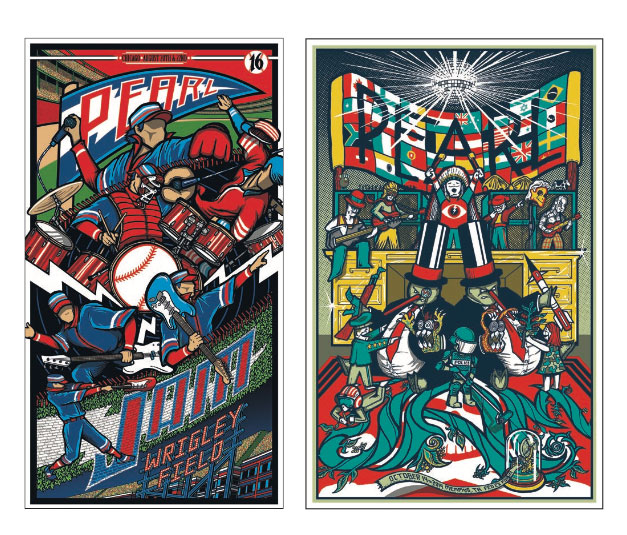
Could you discuss any specific Pearl Jam design that presented a creative or technical challenge? In the book, several posters and graphic works are highlighted. Which one do you consider to be your most innovative work and why?
I think every poster I do for Pearl Jam the creative challenges is usually “what am I going to do this time?” After years of doing posters for Pearl Jam, or any band for that matter, each poster you have to think “what am I going to do?” but when you’ve created many different images over the years for a band that question becomes even harder to answer. What am I going to do that I haven’t done for this band before? What can I reference that I haven’t before? What vibe can I incorporate that I haven’t before?
My most innovative work… hmmm, I feel like my answer to this would change depending on what day you asked me, but one of my favorites is a poster I did for the Queens of the Stone Age, for a show they played in Salt Lake City, UT in 2017. I absolutely LOOOOVE The Queens of the Stone Age, and that poster is based off their song the Feel Good Hit of the Summer, which the lyrics are just a repeated list of drugs singer Josh Homme says he was one walking to the studio to record the album one day. And for fans of the band they know that Josh learned how to play guitar learning polka music… if you listen to their music you can often hear the polka “ump-pa” rhythm that is the foundation of the scary out of control groovy gypsy traveling carnival menacing circus that is the Queens of the Stone age… so for that image I have the personification of the drugs listed in the song: nicotine, valium, vicodin, marijuan, extasy, alcohol and cocaine, all assaulting a polka band… and this is all happening inside the head of Josh Homme, the creative mechanisms behind the magic… it’s maybe not my most innovative poster but in my mind it’s a perfect poster… and it’s for a show in Salt Lake City which is known for being a bit of a more religiously minded town that abstains from the evils of vice, so always kinda fun to present imagery that might also ruffle a few feathers when the big rock show comes to town.
What role have the members of Pearl Jam played in the creative and editorial process of the book?
With the exception of Jeff writing the forward and Ed writing the intro, they have had no role in the creative or editorial aspect of the book.
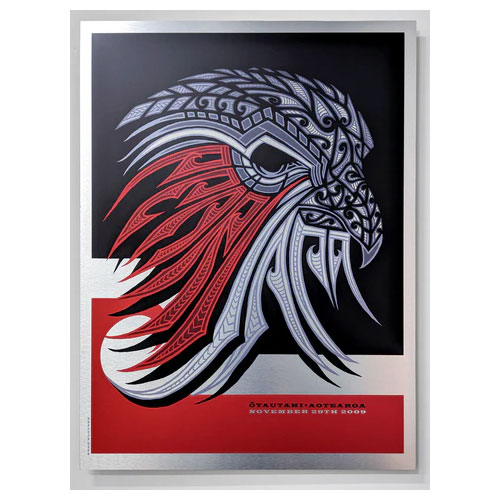
How has your design style or approach changed since you started working with Pearl Jam?
When I was fresh out of college, I was very into using all the design software I had just learned to use, like Photoshop and Illustrator for everything.. I had a much more tech driven style, I wasn’t relying as much on hand drawn work, more on manipulating found imagery in Photshop. Once I got to Seattle, and working for Pearl Jam, there’s a much heavier reliance on hand made art, on illustration and painting, and screen printing. A more analog organic approach then a digital one. Being around all that made me go back to illustrating by hand and that opened up a whole new aspect to my style. And working with Jeff on album art and other projects, I learned a lot just by seeing how he approached art, the freedom through which he let creativity manifest. The idea that art often times is that first initial motion or creation that just naturally happens, the idea that there are no “happy accidents”.
The book mentions your work from the early days of Pearl Jam. How has the band’s evolution been reflected in your graphic work over the years?
Well, I was not there during the early years. I began working for the band at the very end of 1999. So the band was already well established at that point. However, I have been making posters for them for 20 years now, and the band continues to evolve with every album… and as a poster artists you try and capture the sounds and vibe of each album, I am not sure I can pinpoint any specific changes reflected in my work other then as the band gets older and I do to, hopefully both of our respective work has been more thoughtful and developed and honed as we continue to try and master our crafts.

How do you approach the task of reflecting a band’s identity and message through graphic design?
It’s the hardest aspect about creating imagery for bands. Trying to turn not only music, auditory sound, into a visual representation, but to also visually represent a band’s ethos and ideology and image. The first thing I do is listen to the music, and sit with the music and see what imagery or vibes it evokes in my mind. Watching live concert footage also helps one get a better idea about what seeing a band live is like, what the experience is like… but then how do you represent an experience and vibes and energy visually? If a band is loud and heavy, you use maybe more gritty and dark imagery and textures and composition, whereas if a band’s music is more mellow and prettier, you might utilize cleaner lines and maybe more negative space and lighter colors… you try and evoke the vibe of a band in the vibe of the imagery. It’s tough to do, but part of the fun of the job. And why it’s always so cool to see how different poster artists interpret a band and their music.
What impact do you hope this book will have on Pearl Jam fans and followers of musical graphic design?
I hope it will give Pearl Jam fans and graphic design fans more insight into what goes into the creation of a gigposter. They’ll get to have some insider trading on what goes on behind the making of each piece. They’ll get to see how the sausage is made, and learn more about each image and the stories behind them. As an artist, I always love getting to see the making of an artist’s work, so hopefully fellow artists out there will get something out of seeing how I make my work, cause it’s always interesting to see how similarly or differently artists create their work .
Do you have plans for other similar projects or collaborations on the horizon that might interest fans of musical graphic design?
I am always working on posters for different bands, so the projects on the horizon are more posters for rock and roll shows!